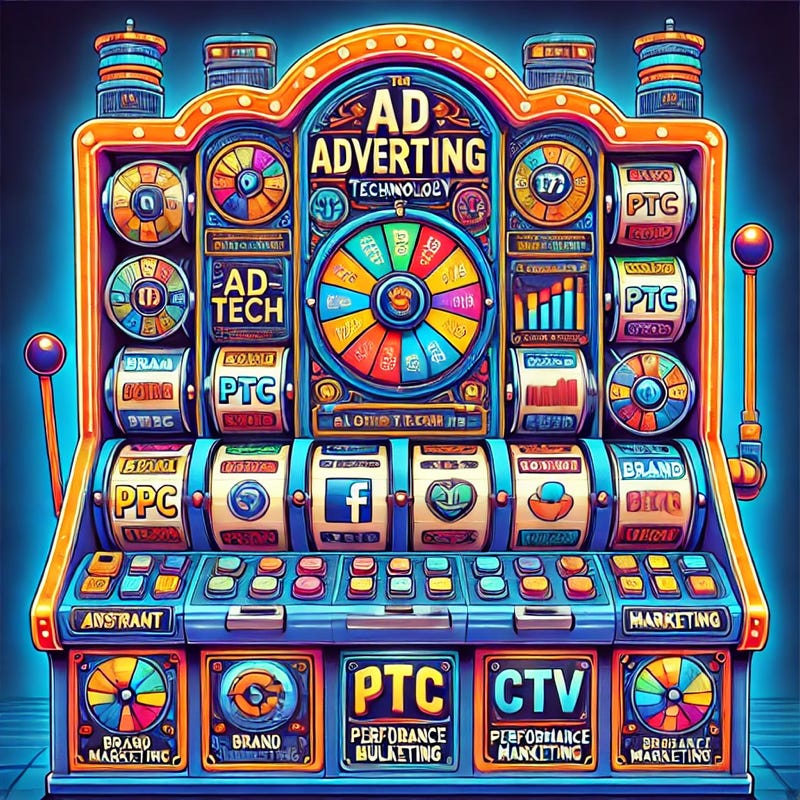Brand vs. Performance: The Explore-Exploit Dilemma in Modern Marketing
Or why CMOs are betting on quick wins and leaving the table early
This year, performance spending on Connected TV has surged to unprecedented levels, fueled by the rise of sophisticated attribution systems that provide marketers with near-instant feedback on campaign effectiveness. These tools make it easier than ever to justify investments in performance-driven tactics, as the data clearly shows how such strategies translate into immediate sales or conversions. Yet, despite these advancements, marketers continue to grapple with the age-old dilemma: should they allocate budgets toward brand-building initiatives with long-term payoffs or focus on performance marketing to drive short-term results?
In the world of data science, this tension is known as the explore-exploit conundrum. It’s a mathematical problem that models decision-making under uncertainty, where one must balance the need to explore new opportunities (which may yield higher rewards) with the desire to exploit proven strategies (to maximize immediate returns)
The multi-armed bandit problem is a mathematical model for understanding the explore-exploit tradeoff. Imagine a gambler faced with a row of slot machines (or “bandits”), each with an unknown payout probability. The gambler aims to maximize their total reward over a series of pulls. To do this, they must decide how to allocate their attempts—exploring different machines to learn about their payout rates while exploiting the machine that offers the best return. The dilemma arises because every pull used for exploration is not spent exploiting a potentially better-known machine, creating a tradeoff between gathering information and reaping the rewards.
There are many solutions to this problem; the Upper Confidence Bound algorithm is an easy-to-understand one. This approach balances exploration and exploitation by prioritizing machines with high average payouts and high uncertainty about their performance. It calculates a confidence interval for each machine’s average reward and selects the machine with the highest upper bound of this interval. This approach ensures that lesser-tested machines are occasionally played, reducing the risk of prematurely committing to suboptimal choices. Over time, the algorithm converges on the optimal strategy by systematically narrowing the uncertainty, making it a powerful tool for decision-making in uncertain environments.
For marketers, this framework translates directly into strategic decisions. Should a company experiment with untested, potentially high-impact tactics like emerging platforms or innovative messaging? Or should it double down on proven channels that guarantee immediate conversions? The answer depends on the organization’s appetite for risk, the length of its planning horizon, and its ability to endure short-term uncertainty for long-term gain.
CMOs and CFOs often find themselves unwitting participants in a multi-armed bandit game as they allocate budgets across marketing strategies. Short-term tactics like pay-per-click advertising or promotional campaigns represent a simpler version of the problem. Here, feedback loops are quick—marketers can run A/B tests or analyze immediate ROI, exploring various strategies rapidly before committing to the most effective ones. However, the game is significantly more complex when considering long-term investments like brand-building, where the “arms” (strategies) may take years to reveal their actual value.
Research consistently highlights the profound impact of brand equity on consumer behavior and business outcomes. Strong brands drive price premiums, reduce customer acquisition costs, and enhance customer loyalty. Studies, such as those by Les Binet and Peter Field in their seminal work on the long-term effects of advertising, reveal that brand-building efforts create compounding returns over time, even as short-term sales activation delivers immediate but often fleeting results. The challenge is that these long-term strategies require exploration over extended periods, during which leaders must resist the pull of short-term exploitation.
The fundamental problem is that short-term marketing strategies have an inherent advantage in measurability. Metrics like click-through rates, conversions, and immediate ROI provide quick and tangible feedback, allowing marketers to assess the effectiveness of campaigns almost in real-time. This creates a natural bias toward short-term tactics, as their outcomes can be tracked, optimized, and reported confidently. In contrast, long-term strategies like brand-building operate on delayed timelines, making their impact harder to quantify. Metrics such as brand equity, consumer loyalty, and lifetime value are abstract and often require years of consistent investment to materialize. This disparity creates tension in resource allocation, with short-term approaches usually winning out in environments where quick wins are valued over enduring growth.
This focus on short-termism also seems to be playing out in the boardroom. CMOs in consumer-facing Fortune 500 companies face average tenures of approximately four years, with over 20% serving for a year or less. This limited time horizon amplifies the bias toward short-term strategies, as CMOs must deliver measurable results quickly to secure their position. Meanwhile, CFOs, who typically remain longer in their roles, naturally emphasize immediate performance metrics, further entrenching the preference for tactics that yield fast and quantifiable outcomes. This discrepancy in priorities often leaves CMOs between needing to drive short-term results and wanting to invest in brand-building strategies that may not pay off until well after their tenure.
The result is a self-reinforcing cycle. Many CMOs don’t stay in their roles long enough to see the benefits of brand investments, leading them to prioritize strategies that deliver results within their time horizon. This short-term focus may, in turn, contribute to higher turnover as CMOs face pressure to demonstrate immediate impact.
The question then becomes: do CMOs avoid brand-building because they won’t be around to reap the rewards, or is their failure to focus on the long term a reason for their early departures? Either way, the structural incentives in many organizations appear misaligned with the enduring benefits of a strong brand, raising critical questions about how leadership stability and strategic focus could better support long-term marketing success.



